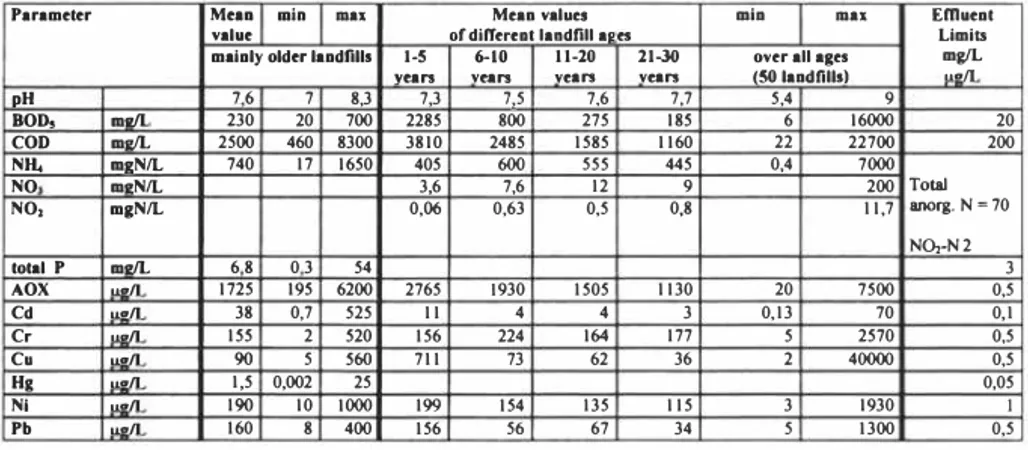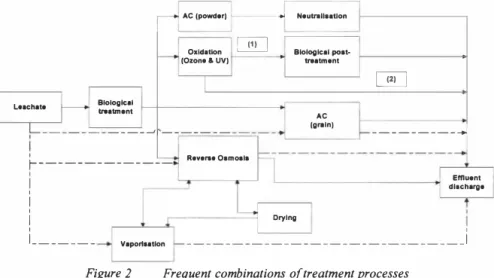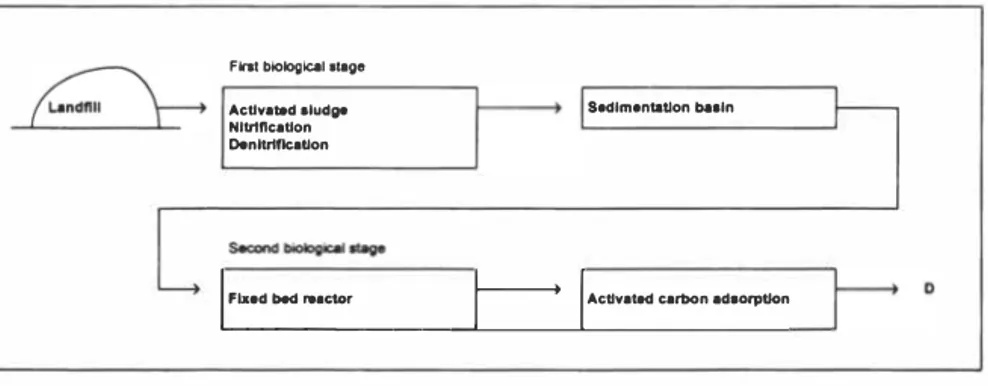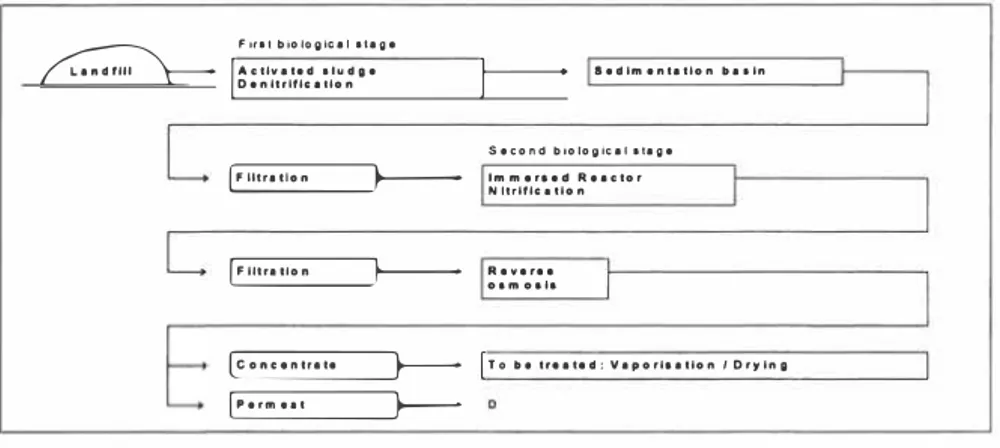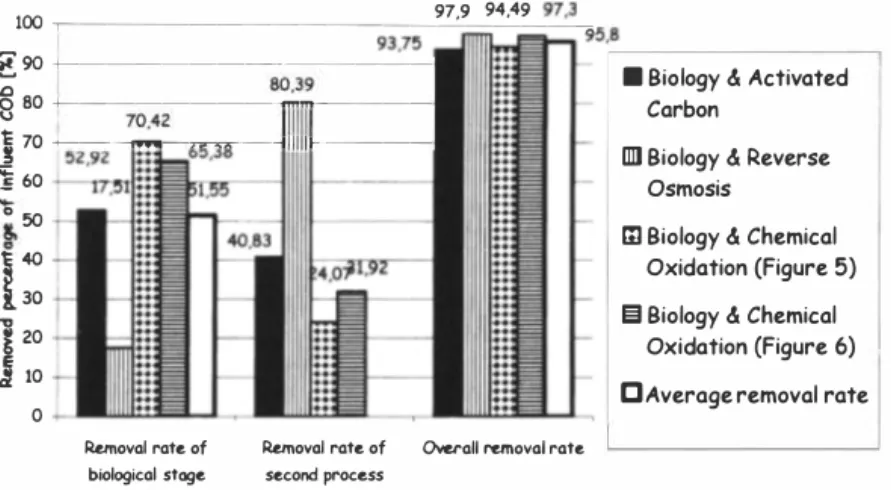2
KALMAR ECO-TECH'0I
Leachate and Wastewater Treatment with High-Tech and Natural systems KALMAR, SWEDEN, November 26-28, 2001
LEACHATE TREATMENT IN GERMANY
Ulrike Witz, Han:rJurgen Ehrig Department of Water and Waste Management, University ofWupperta/, Pauluskirchstrasse 7, D42285 Wupperta/, Germany ABSTRACTLandfill leachate is a problem that has to be dealt with not only today but also in the near and distant future. Generally, leachate production takes place after the closure as well as during the operation of a landfill. As previous studies show the process of leachate output continues for decades if not centuries after the end of the landfill operation. Therefore the problem of leachate output, and subsequently its treatment, remains after the closure. Another important fact is that leachate characteristics vary within a wide range over time in quantity and quality. A lot of research has been done in order to investigate the efficiency of different leachate treatment processes. Since no standard treatment system has been developed so far, a number of different systems have been implemented.
In Germany about 150 leachate treatment plants were operated in full scale, in 1998. Mainly three different systems are applied. The most common treatment system consists of a combination of a biological stage and an activated carbon filtration. Another frequently used system combines biology and reverse osmosis. Thirdly, the combination of biology and chemical oxidation is used relatively often. Other feasible systems with different process combinations are used in practice. In any case it is remarkable that nearly all systems include a biological stage.
Although the described treatment systems are already in use for a number of years, many of them still have serious operational problems. This results mainly from their complex technical structure which makes it difficult to solve the problems. An additional obstacle is the long term operation of such systems. It is unlikely that today's high-tech treatment systems with high operational costs and maintenance expenditure will be operated over the leachate output period. Further research should therefore concentrate on developing simple, reliable techniques that can be operated without maintenance. Since all present treatment systems are set up with biological stages it seems reasonable to examine whether biological processes can be used individually for long-term leachate treatment. For this reason we are currently investigating the performance of soil filters with regard to Ammonia removal from landfill leachate at the University of Wuppertal.
KEYWORDS
Leachate characteristics, Leachate production, Treatment processes and systems, Biological process
nan nan 7,3 555 m2N/L meN/L 54 1. INTRODUCTION
The present waste management strategy in Germany is based on the waste disposal law (Abfallbeseitigungsgesetz), which has firstly been adopted in 1972. Until then neither had waste been deposited separately nor had waste disposal sites been sealed at the basis. Today waste is deposited according to the type and/or source of waste. There are special landfill sites for municipal waste, waste from construction sites, and industrial wastes etc. This has direct implications for the leachate originating at these sites. Although landfill sites for different waste types are in operation, reliable data is limited. In addition data about the long-term pollution potential of waste is limited to the results of lab-scale experiments.
For the design of a leachate treatment system it is crucial to gain data about the expected quality and quantity of leachate (3,4). But it is difficult to determine the exact values in advance since a number of factors influence these aspects. Additionally strong short-term fluctuations and long-term variations of quantity and quality occur. However, during the last two decades a number of different treatment systems have been developed. In general, these systems consist of high-tech process combinations that result in effluent values below the current limits. The expenditure connected to these systems can be justified for the operational period and for the succeeding aftercare period, but not for the long-term leachate production period.
2. LEACHATE QUALITY
The composition of leachate depends mainly on the landfilled waste but also on the varying chemical, physical, and biological processes within the landfill body. A huge number of different substances can be found in the leachate. In Table I only a selection of these substances is included, but it is obvious that the concentration varies in a wide range. Although the data represents a period of approximately 25 years, a change over time cannot be found. The main reason for this is that the lower waste layers determining the leachate characteristics are already old. For the assessment of leachate quality though, especially with regard to the aftercare period, only few parameters (COD, AOX, Nitrogen, and 80D5) are
important (4). In Germany, limits for effluents from disposal sites have been introduced some years ago. These limits are included in Table I.
Parameter Mun min m11 Mtao valuu min m11 Effluent
value or differtat landfill a, es Limiu
mainly older landfills 1-5 6-10 11-20 21.JO overall ages mg/L
nan {50 landflllsl uo/1 vean off 7 6 7 8,3 7,5 7,6 7,7 5,4 9 BOD, me.II 230 20 700 2285 800 275 185 6 16000 20 COD me.IL 2500 460 8300 3810 2485 1585 1160 22 22700 200 1650 405 600 445 0,4 7000 NIL 740 17 NO 3,6 7,6 12 9 200 Total anorg. N ~ 70 NO, mgN/L 0,06 0,63 0,5 0,8 11,7 NO,-N2 total P me.IL 6 8 0 3 AOX uo/1 1725 195 6200 2765 1930 1505 1130 20 7500 0,5 Cd uo/1 38 0,7 525 11 4 4 3 0,13 70 0,1 Cr uo/1 155 2 520 156 224 164 177 5 2570 0,5 Ca uo/1 90 5 560 711 73 62 36 2 40000 0,5
"·
uo/1 1,5 0,002 25 0,05 NI uo/1 190 10 1000 199 154 135 115 3 1930 Pb ua/1 160 8 400 156 56 67 34 5 1300 0,5 Table 1 Substance concentrations in landfill leachate from different aged landfill sitesUlrike Witz, Hans-Jllrgen Ehrig, Germany
3
I
.. 30m/300mm . .§.2000 -=-:---'"'"-,"-==
1
�;J
:;t
:
':i.
:
';:.
:
i
::
r:.
:
r;.
:i:
;� �
'ii.
:
-;;.
�
f.
;
'rl
:l
=
t:.
�r�� �
'C!.
�
":t,
�
-:;.
�
'C:.
_i_:
; =�::�_:
��,:
S���;�__;::;;;;;:�:;ii_:;::
� t
t.
t ::
":!
j
::� =. '::Ii ';:. ;;, =. KALMAR ECO-TECH'0lLeachate and Wastewater Treatment with High-Tech and Natural systems KALMAR, SWEDEN, November 26-28, 200 I
Compliance with today's legislation in Germany requires separate treatment facilities for leachate, as only elimination of Nitrogen and BOD is possible in municipal wastewater treatment plants. Depending on the local situation even more stringent limits can be required from the landfill operator. However, different treatment processes have to be combined in order to set up leachate treatment systems that achieve compliance with the legal effluent standards.
3. LEACHATE QUANTITY
The production of leachate depends mainly on the infiltration of rainfall. As a result it is relatively difficult to evaluate the leachate quantity (I). However, strong short-tenn fluctua tions can be observed in most landfill bodies. Subject to the type of waste it is possible to reduce the production ofleachate for a limited time (short-tenn storage). This is influenced by the landfill technique as well as by the landfilling height. During the last 20 years the compo sition of waste (less water adsorbing fractions) and in addition the landfill technique (high density, penneability) changed. Resulting from this the infiltration ratio rose. Currently the operated landfills are likely to infiltrate between 40 and 70 % of the precipitation (3). Apart from the influence of the seasons, the capacity and state of the drainage system affect the leachate quantity. Attached to the quantity of water that infiltrates the landfill body is the quality of the collected water at the bottom of the landfill. The more water flows through the landfill, the lower becomes the pollutant load of the leachate. Lab-scale experiments show that the infiltration behaviour of waste will change in the near future. Due to biological pre treatment combined with other processes, the landfilled material will have a higher density and a lower infiltration capacity. Thus the leachate quantity and quality will change, too. Nevertheless the long-tenn emission and pollution potential remain. This problem needs to be addressed with regard to the long-tenn aftercare of a landfill body (3,4).
4. LONGTERM POLLUTION POTENTIAL
One considerable peculiarity of leachate when compared to other wastewaters is the production time. Leachate is produced not only during the landfill operation period but also after the closure of the landfill. Thus the pollution and emission potential of leachate remain for geological times. For the continuing treatment of landfill leachate it is important to know which parameters have to be taken into account (I). Looking at the development of the COD concentration over the time (Figure 1) it is obvious that this is one of the parameters that has to be cared for. 4000
1!1::"---,
-10m/300mm - - ... • 10m/112,5mm · · ,.. · 10m/300mm • • ... · 10m/112,5mm 30m/300mm 3500 3000 -30ml112,5mm -30mt112,5mm �2500 t-.,---�,---= ... c:---g1500+--=..---c=:---"---..==--��---",,,..., _--Effluent Limit 200 mg/I.. :::--________ ---t
0 50 100 150 200 250 300
nme (years) 0
As the diagram shows, the pollutant load will be reduced over time. But in fact, the reduction of the pollutant concentration slows down, too. A similar reduction occurs with AOX and Nitrogen.
According to present legislation leachate has to be treated until the pollutant values are below the effluent limits. For parameters with high long-term concentrations it is therefore necessary to ensure treatment for at least I 00-200 years. The current practice of applying non permeable top-covers prolongs the long-term aftercare peri�d, since the pollution potential remains within the landfill body.
5. TREATMENT SYSTEMS
In 1998, approximately 150 separate leachate treatment plants were in operation in Germany. Figure 2 shows the most commonly used treatment combinations.
The dotted lines indicate other possible process combinations. But in contrast to all other options these combinations are only used for special problems. The majority of the operational systems use a biological stage as the first treatment step.
LHchate Blologlcal ir.1tment
AC (powder) f----_.. Oxidation (Ozon•& UV) � Neutnlla■Uon Biological poet• natment AC (grain)
[£C]
-- --- ----�1--- - ---+, I �--- Revera• Oamoal■ I I I I I Drying Effluent dlacharge I ! ______ _ VaporiHtlon ____________________________ _!Figure 2 Frequent combinations of treatment processes full lines: most commonly used treatment combinations
dotted lines: possible process combinations
From the 150 operational leachate treatment plants 58 plants used activated carbon adsorption in combination with biology. Other 49 plants combined the separation of pollutants through reverse osmosis with a biological stage. Relatively common is also the combination of biology and chemical oxidation (5).
Ulrike Witz, Hans-Jllrgen Ehrig, Germany
_ _ _ _ _ ____
KALMAR ECO-TECH'0l
Leachate and Wastewater Treatment with High-Tech and Natural systems
KALMAR, SWEDEN, November 26-28, 2001
Treatment processes and frequently used process combinations
Frequently used process combinations are shown in Figure 2. Most currently operated treatment systems combine at least two processes. The further described treatment systems have been in operation for a number of years, but most of them are still not working without problems. Frequently this can be explained by basic reasons: either the technical systems have been installed without prior testing for leachate treatment, or the peculiarities of leachate have not been taken into account. In addition, often staff does not get appropriate training. The advantage of subsequently presented data is that it represents the reality since these systems have been in operation for 10 to 15 years. But on the other hand these systems do not stand for up-to-date technique.
Biological processes
This process is commonly the first treatment procedure for leachate. The biological treatment process is a real elimination process. Mainly Carbon and Nitrogen compounds are reduced by nitrification and denitrification. Through adsorption at the surface of activated sludge a smaller part of pollutants can be removed. Usually biological treatment takes place in activated sludge basins or in fixed bed reactors. The advantage of this process is that it can easily be combined with any other process.
Physical processes
Adsorption processes remove predominantly organic substances. These are adsorbed to the
surface of the adsorbent, which is in most cases, activated carbon. Two process procedures are possible: either the leachate flows through filter columns filled with grained carbon or the pulverised carbon is added to the water. The advantage of the grained carbon is that it can be reactivated thermically. The pollutants are destroyed in addition to the carbon reactivation. The pulverised carbon, however, has to be separated from the liquid phase. It cannot be reactivated and therefore this process is not used anymore (3).
Fnt biok>glcal stage
Activated sludge Sedlmenlltlon baeln
Nitrification Oenltrtflcatlon
�I
, b< od bod ... ·""_,r
I
AcUvated carbon odao,ptlon� � � � � � �
Membrane processes divide the leachate inflow into a low polluted permeate and a high polluted concentrate. Different membrane techniques are available for leachate treatment. These are nanofiltration and reverse osmosis. Depending on the membrane size, the molecule size and the applied pressure varying substances can be removed. In fact the removal process is not finished without further treatment of the concentrate. Commonly the post-treatment consists of vaporisation and drying. These measures are usually implemented as post treatment processes for concentrate from reverse osmosis processes (4).
F 1r1t biol09lc1I 11191
Actlv1t1d 1ludg1 l1dlm1nt1tlon b11ln
1 D1nltdflc11lon
Second biologlc:11 11191
Imm er11d Ra actor N llrlflc■ llon
R1v1r11 oam 0111
[To ba tn■t■d: Y1porl11t1on I Dryln11
Figure 4 Combination II: Biology & Reverse osmosis; D = Discharge
Chemical processes
The most frequently used chemical treatment process is the chemical oxidation process. By adding a strong oxidant to the water, organic substances are destroyed. The process can be intensified by using UV-light in order to raise the reaction capacity and reaction time. Biologically degradable substances should be eliminated in a biological pre-treatment stage in order to use the oxidation process efficiently (minimisation of the required energy input). The following substances can be eliminated through the oxidation process: COD, DOC, TOC; PAK, AOX and others. An advantage is that the residuals of this system require no further treatment. As the chemical characteristics are altered by the oxidation, it can be useful to treat the leachate subsequently in a second biological stage (2).
Finl biological stage
Sadlmantatlon baaln � Activated aludga
Danl•Nltrl•lnt■rmlttand Dani
� IO•ldatlon with ozone
Second biological stage
j1mm1ra1d Reactor � D
Figure 5 Combination Ill: Biology & Chemical oxidation I; D = Discharge
Ulrike Witz, Hans-Jllrgen Ehrig, Germany
KALMAR ECO-TECH'0l
Leachate and Wastewater Treatment with High-Tech and Natural systems KALMAR, SWEDEN, November 26-28, 2001
Figure 6 shows a simpler operational treatment system that also consists of a biological stage and a chemical oxidation step. Depending on the leachate quality different stages can be combined in order to achieve an efficient treatment. Even the reactor containers for the ozonisation vary from treatment plant to treatment plant. But so far no studies have been published that investigated the efficiency of the different reactor types (4).
First biological stage
Activated aludga Oxidation with o:rona (and UV•
Nitrification light)
Denltrlficatlon
Figure 6 Combination IV: Biology & Chemical oxidation II; D = Discharge
The results for the removal efficiency (influent COD/effluent COD) for each described treatment combination is summed up in Figure 7.
Performance and Efficiency
Figure 7 represents COD-data from operational systems that have been described before. Generally the overall performance is satisfactory, though most substances are removed relatively unspecified by the implemented treatment systems. Therefore most systems cannot be used to their full capacity. Figure 7 shows that the biological stage is a very efficient process, in average more than 5 1 % of the influent COD can be removed. The efficiency of the second treatment process varies between 24,07 and 80,39 %.
97,9 94,49
100 ,---:=----,.
l�
�
--
-
---
--
---
■
Biology & Activated8
80 +---ftffm----\J Carbon
po
�---,--��---1111111--- 1111 Biology & ReverseE 60 Osmosis
0 !50
m
Biology & Chemical Oxidation (Figure 5)
1:
l
ml Biology & Chemical20 Oxidation (Figure 6)
&
10C Average removal rate 0
Removal rate of biological stage
Removal rate of Overall removal rate second proce.ss
In addition to the importance of the attainable effluent values the residuals are significant, too. One main reason for the significance of the residuals from leachate treatment is its origin • landfill sites. Together with other reasons this is one of the main factors that drive the waste minimisation strategy. The waste minimisation strategy on the other hand detained an environmental assessment of the diverse treatment systems so far.
For the overall assessment of those systems other aspects like resource and energy consumption or the quality and environmental impact of the produced residuals are also important. Table 2 shows the amount of residues and the specific energy demand for each treatment combination.
Combinations Amount of residues Specific energy demand
lko/mA J leachate! lkWh/mA J leachate!
without chemicals with chemicals without chemicals with chemicals
B & AC 0 I - 2,6 1,7 - 7,4 1 6 - 28 26 • 78
B & RO 0,5 • 1 ,0 2,4 · 3,8 25 • 30 29 . 45
B & CO • ffi2. 5\ 0 - 1,8 4,5 • 1 1,8 65 • 125 73 - 1 60
B & CO · (Fi2. 6) 0,5 • 2,4 3,7 · l 0,5 45 • JOO 52 • 130
Table 2 Amount of residues and specific energy demand for different treatment systems
The biological treatment stage generally produces sludge that has to be treated further. With view to the legal effluent limits the biological stage is usually designed as low loaded treatment stage. This results automatically in a mass reduction of the originating sludge. Due to the low pollution load and long detention times the energy demand can be relatively high, depending on the applied biological treatment technique (activated sludge basins or fixed bed reactors). A post-treatment with membrane processes retains the biomass and therefore further reduces the sludge production. Oxidation processes are generally residual-free, so are adsorption processes. But in combination with biological treatment residuals occur during the leachate treatment process. It is common to reduce the production of residuals and more importantly the energy demand and resource consumption by implementing a biological pre treatment step.
6. CONCLUSION
Generally separate treatment of landfill leachate is obligatory in Germany. Not only in order to eliminate biologically non-degradable substances but mainly to comply with the legal effluent limits. In order to achieve a sufficient reduction of the pollutant load it is essential to implement combinations of different treatment processes. Suitable systems become very complex. Nevertheless often the pollutants are removed relatively unspecified.
Factors like a high expenditure for the design and maintenance of the treatment plant will be included in the overall environmental assessment of future treatment systems. The development of further treatment systems will include largely the use of biological treatment processes. Particularly, since Nitrogen elimination becomes more and more essential with ageing of the landfill. Another motivation for further research of simple techniques is the leachate production time, which extends the operational time. Systems that can be operated over a long period of time without maintenance will rely on biological processes. Therefore a lot of studies investigate the possibility to run reliable, flexible biological systems that remove the pollutants efficiently.
Ulrike Witz, Hans-JUrgen Ehrig, Germany 46
KALMAR ECO-TECH'0l
Leachate and Wastewater Treatment with High-Tech and Natural systems KALMAR. SWEDEN, November 26-28, 200 I
REFERENCES
L A TV ( 1993 ), A TV -Arbeitsbericht Deponiesickerwasser-Behandlung, Korrespondenz Abwasser Nr.3, 40, Jahrgang, 1993
2, ATV ( 1996), A TV-Arbeitsbericht Deponiesickerwasser-Behandlung, Korrespondenz Abwasser Nr,7, 43, Jahrgang, 1996
3, Ehrig, H.-J, and Hagedorn, S,, (1999), Sickerwasserbehandlung, Belastungen, Verfahren, Entwicklung und Bewertung, Hamburger Berichte
4, Ehrig, H,-J., (200 1 ), Sickerwasser aus Abfallablagerungen, In: Sonderdruck aus ATV Handbuch lndustrieabwasser Dienstleistungs- und Veredelungsindustrie, 4.Auflage. ATV-DVWK, Hennef, 2001
5, Rettenberger, G., Leachate Treatment Plants In Germany, In: Cossu, R., Lavagnolo, M.C., Management and Treatment of MSW Landfill Leachate. Proceedings International Training Seminar, Venice 1998, CISA, Cagliari, Italy
